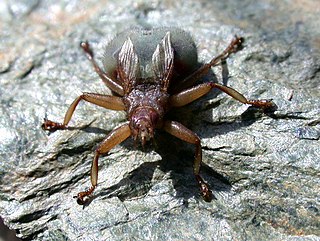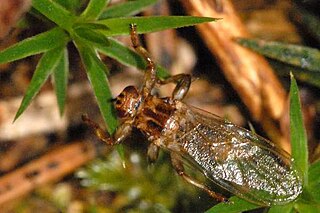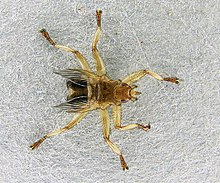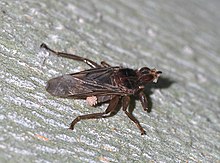
Hippoboscoidea is a superfamily of the Calyptratae. The flies in this superfamily are blood-feeding obligate parasites of their hosts. Four families are often placed here:

The Streblidae are a family of flies in the superfamily Hippoboscoidea, and together with their relatives the Nycteribiidae, are known as bat flies. They are winged or wingless ectoparasites of bats, and often have long legs. They appear to be host-specific, with different species of bat flies occurring only on particular species of bat hosts, sometimes with multiple species of flies sharing a host bat.

Nycteribiidae is a family of the true fly superfamily Hippoboscoidea are known as "bat flies", together with their close relatives the Streblidae. As the latter do not seem to be a monophyletic group, it is conceivable that bat flies cannot be united into a single family.

Lipoptena cervi, the deer ked or deer fly, is a species of biting fly in the family of louse flies, Hippoboscidae. These flies are commonly encountered in temperate areas of Europe, Siberia, and northern China. They have been introduced to North America. They are parasites of elk, deer, and other deer family members, burrowing through the fur and sucking the blood of the host animals. Adults are only 5–7 mm (0.20–0.28 in) in length and brownish in colour. Their bodies are flat and elastic, making their removal difficult. L. cervi is a poor flier and can only fly for short distances. Once the insect reaches its target, it sheds its wings and starts burrowing through the fur.

Lipoptena is a genus of Hippoboscidae, known as louse flies or keds.

Crataerina is a genus of louse flies in the family Hippoboscidae. All are parasites of birds, feeding on the blood of various species of Apodidae (swifts) and Hirundinidae. The genus is sometimes spelled Craterina.
Hippoboscinae is a subfamily of the fly family Hippoboscidae. All are parasitic, and unlike some other members of the Hippoboscidae, all Hippoboscinae are winged species.

Lipopteninae is a subfamily of the fly family Hippoboscidae. All are parasitic.

Pseudolynchia canariensis, the pigeon louse fly or pigeon fly, is a species of biting fly in the family of louse flies, Hippoboscidae.

Pseudolynchia are genus of biting flies in the family of louse flies, Hippoboscidae. There are 5 known species. One of the more well known species is the pigeon louse flyPseudolynchia canariensis. All species are parasites of birds.
Stilbometopa are genus of biting flies in the family of louse flies, Hippoboscidae. There are 5 known species. All species are parasites of birds.
Microlynchia is a genus of biting flies in the family of louse flies, Hippoboscidae. There are four known species. All species are parasites of birds. Microlynchia differs from Pseudolynchia in the presence of minute ocelli and a differently shaped scutellum.
Ortholfersia is a genus of biting flies in the family of louse flies, Hippoboscidae. There are 4 known species. All species are parasites of macropods.

Icosta are genus of biting flies in the family of louse flies, Hippoboscidae. There are 52 known species, making it the largest Hippoboscid genus. All species are parasites of birds.
Ornithoica are a genus of biting flies in the family of louse flies, Hippoboscidae. There are 23 known species. All species are parasites of birds.

Ornithomya are genus of biting flies in the family of louse flies, Hippoboscidae. There are 29 known species. All species are parasites of birds.
Myophthiria is a genus of biting flies in the family of louse flies, Hippoboscidae. There are 13 known species. All species are Parasites of birds.
Ornithoctona are genus of biting flies in the family of louse flies, Hippoboscidae. There are 12 known species. All species are parasites of birds.

Ornithomyinae is a subfamily of the fly family Hippoboscidae. All are blood feeding parasites, for the most part on birds, though some have mammals as hosts.
Hippobosca longipennis, the dog fly, louse fly, or blind fly, is a blood-feeding parasite mostly infesting carnivores. The species name "longipennis" means "long wings". Its bites can be painful and result in skin irritation, it is an intermediate host for the canine and hyaenid filarial parasite Dipetalonema dracunculoides, "and it may also be a biological or mechanical vector for other pathogens".









